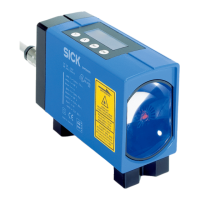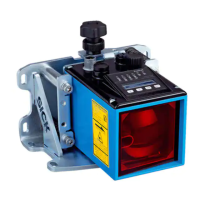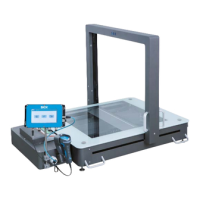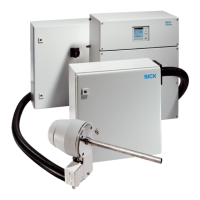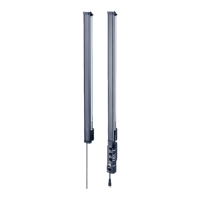16 DUSTHUNTER T · Operating Instructions · 8012428 V 2.0 · © SICK MAIHAK GmbH Germany
Product Description
2.1.3 Function check
A check cycle can be triggered at fixed intervals as from a definable starting timepoint for
an automatic function check of the measuring system. The setting can be made using the
SOPAS ET operating program (
→
p. 67, §4.4.3). Any unallowed deviations from normal
behavior that may occur are signaled as errors. A check cycle triggered manually can help
localize possible error causes should a device malfunction occur.
A check cycle runs for approx. 300 s and comprises:
● Approx 30 s measurement of contamination of optical surfaces (not for DUSTHUNTER
T50), zero and control value
● 90 s each (standard value) output of values determined.
Figure 3 Check cycle output on a plotter
Further information → Service Manual
Contamination degree
(Live Zero = 0%,
20 mA = 40%)
Contamination output
Control value output
(70%-value, span)
Zero value output (Live Zero)
Check cycle
start
Control value
determination
Paper feed
Check cycle
end
● The output duration can be set using a parameter (
→
p. 67, §4.4.3).
● The analog output must be activated to output check values on the analog
output (
→
p. 67, §4.4.3).
● The value measured last is output on the analog output during control
value determination.
● If the check values are not output on the analog output, the current
measured value is output when control value determination has completed.
● Relay 3 is activated (
→
p. 46, Fig. 27) on the DUSTHUNTER T100 and T200
versions during a check cycle.
● A check cycle is not started automatically when the measuring system is in
"Maintenance" mode.
● A check cycle is started automatically 1 min after switching from
"Maintenance" to "Measurement" mode.
● Function check" is displayed on the display during the check cycle when
using a control unit with the optional Display module.
● If the start timepoint or cycle interval are changed, a check cycle timed
between parameter setting and new start timepoint is still carried out.
● Changes to the interval time are first effective after the next start
timepoint.
